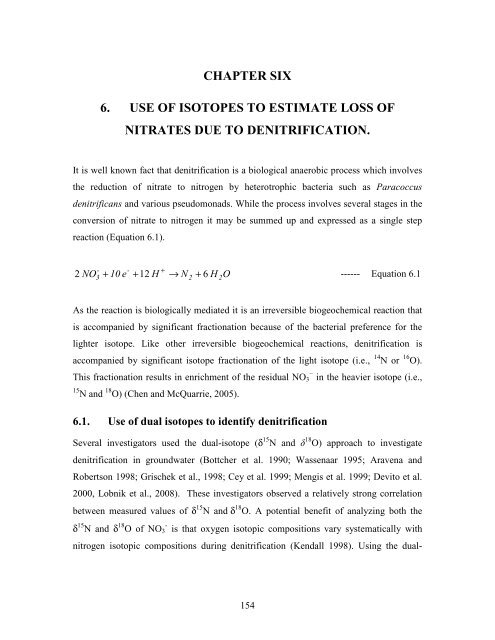THE FLORIDA STATE UNIVERSITY ARTS AND SCIENCES ...
THE FLORIDA STATE UNIVERSITY ARTS AND SCIENCES ...
THE FLORIDA STATE UNIVERSITY ARTS AND SCIENCES ...
Create successful ePaper yourself
Turn your PDF publications into a flip-book with our unique Google optimized e-Paper software.
CHAPTER SIX<br />
6. USE OF ISOTOPES TO ESTIMATE LOSS OF<br />
NITRATES DUE TO DENITRIFICATION.<br />
It is well known fact that denitrification is a biological anaerobic process which involves<br />
the reduction of nitrate to nitrogen by heterotrophic bacteria such as Paracoccus<br />
denitrificans and various pseudomonads. While the process involves several stages in the<br />
conversion of nitrate to nitrogen it may be summed up and expressed as a single step<br />
reaction (Equation 6.1).<br />
-<br />
3<br />
-<br />
2 NO + 10 e + 12 H → N + 6 H<br />
+<br />
2<br />
2<br />
O<br />
154<br />
------ Equation 6.1<br />
As the reaction is biologically mediated it is an irreversible biogeochemical reaction that<br />
is accompanied by significant fractionation because of the bacterial preference for the<br />
lighter isotope. Like other irreversible biogeochemical reactions, denitrification is<br />
accompanied by significant isotope fractionation of the light isotope (i.e., 14 N or 16 O).<br />
This fractionation results in enrichment of the residual NO3 − in the heavier isotope (i.e.,<br />
15 N and 18 O) (Chen and McQuarrie, 2005).<br />
6.1. Use of dual isotopes to identify denitrification<br />
Several investigators used the dual-isotope (δ 15 N and δ 18 O) approach to investigate<br />
denitrification in groundwater (Bottcher et al. 1990; Wassenaar 1995; Aravena and<br />
Robertson 1998; Grischek et al., 1998; Cey et al. 1999; Mengis et al. 1999; Devito et al.<br />
2000, Lobnik et al., 2008). These investigators observed a relatively strong correlation<br />
between measured values of δ 15 N and δ 18 O. A potential benefit of analyzing both the<br />
δ 15 N and δ 18 O of NO3 - is that oxygen isotopic compositions vary systematically with<br />
nitrogen isotopic compositions during denitrification (Kendall 1998). Using the dual-
















